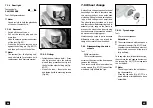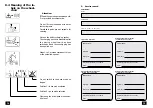
59
58
7.5.6.3 Measuring the acid densi-
ty:
The acid density measurement with the
acid checker gives an indication of the
actual charge condition of the battery
cells.
!
Attention:
Comply with the contents of the
'Safety Information for Electric Vehi-
cles' brochure.
– Always open the sealing cap of only
one battery cell.
With the ball pump pressed, insert
the tube for sucking-in vertically, from
above, into the acid.
– Suck in the acid by slowly releasing
the ball (Fig. 77).
– The floating indicator must swim
freely in the acid.
– Compare the acid level with the
charge scale on the float.
77
Charge the batteries immediately if the
acid density of a cell is lower than the
scale value of 1.18 kg/dm
3
. The battery
is fully charged if the acid level is above
the scale value of 1.28 kg/dm³.
The acid density difference between the
individual cell values should not exceed
0.02 to 0.03 kg/dm³. If it does, this can
be due to battery damage. Seek the as-
sistance of a specialist workshop.
7.5.6.2 Checking the acid level:
The battery acid level falls due to evapo-
ration of water, especially during high
ambient temperature.
☞
Note:
Top up to the correct acid level with
distilled water if necessary.
The acid level is correct when:
– it is just above the filling hole insert
or
– it is approximately 5 mm above the
top edge of the plates (Fig. 76).
☞
Note:
Maintenance-free batteries:
The filling plugs are not visible. – No
maintenance is required. Acid-tight-
ness cannot be measured.
76












































